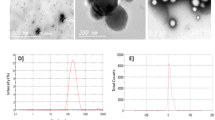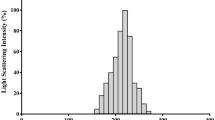Abstract
Colon cancer in men and breast cancer in women are regarded as major health burdens, accounting for majority of cancer diagnoses globally. Doxorubicin (DOX) resistance in breast and colon cancers represents the main reason of unsuccessful therapy. The rationale of this study is to explore whether selenium nanoparticles (nano-Se) can overcome this resistance obstacle of DOX nanoparticles (nano-DOX) in these cancerous cells. Nano-Se and nano-DOX were manufactured and characterized using electron microscopy and Malvern ZetaSizer, applied separately or in the form of combinatorial regimen against human breast cancer cells (MCF7 and MDA-MB-231) and human colorectal cancer cells (HCT 116 and Caco-2). Cytotoxicity, early/late apoptosis, necrosis, cellular zinc, glucose uptake, and redox status were assessed after applying different nano-treatments versus their free counterparts. Nano-DOX induces cytotoxicity in MCF7 and Caco-2 more than MDA-MB-231 and HCT 116 cancerous cells. In addition, nano-DOX plus nano-Se diminish MCF7 and Caco-2 chemoresistance higher than MDA-MB-231 and HCT 116 cancerous cells. Moreover, Se and DOX nano-platforms inhibit glucose uptake. Furthermore, nano-DOX increases nitric oxide (NO) and malondialdehyde (MDA) in cancer cells’ media, while nano-DOX combination with nano-Se rebalances the redox status with zinc augmentation. We reported that Caco-2 cancer cells are more sensitive than HCT 116 cancer cells to nano-DOX and nano-Se. Nano-DOX plus nano-Se induces cytotoxicity-mediated late apoptosis in Caco-2 more than HCT 116 cell lines. This de novo strategy could have great power to overcome the problem of DOX resistance during colon cancer therapy.







Similar content being viewed by others
References
Kotepui M (2016) Diet and risk of breast cancer. Contemp Oncol (Pozn) 20(1):13–19
Smith L, Watson MB, O’Kane SL et al (2006) The analysis of doxorubicin resistance in human breast cancer cells using antibody microarrays. Mol Cancer Ther 5(5):2115–2120
Khaleel SA, Al-Abd SM, Ali AA, Abdel-Naim AB (2016) Didox and resveratrol sensitize colorectal cancer cells to doxorubicin via activating apoptosis and ameliorating P-glycoprotein activity. Sci Rep 6:36855
Xue X, Liang XJ (2012) Overcoming drug efflux-based multidrug resistance in cancer with nanotechnology. Chin J Cancer 31:100–109
Zoheir KMA, Abd-Rabou AA, Harisa GI et al (2015) Gene expression of IQGAPs and Ras families in an experimental mouse model for hepatocellular carcinoma: a mechanistic study of cancer progression. Int J Clin Exp Pathol 8(8):8821–8831
Lehne G (2000) P-glycoprotein as a drug target in the treatment of multidrug resistant cancer. Curr Drug Targets 1(1):85–99
Huang CY, Yu LCH (2015) Pathophysiological mechanisms of death resistance in colorectal carcinoma. World J Gastroenterol 21(41):11777–11792
Mohajeri M, Sahebkar A (2018) Protective effects of curcumin against doxorubicin-induced toxicity and resistance: a review. Crit Rev Oncol Hematol 122:30–51
Księżakowska-Łakoma K, Żyła M, Wilczyński JR (2014) Mitochondrial dysfunction in cancer. Prz Menopauzalny 13(2):136–144
Abd-Rabou AA (2017) Calcium, a cell cycle commander, drives colon cancer cell diffpoptosis. Indian J Clin Biochem 23(1):9–18
Fernandes AP, Gandin V (2015) Selenium compounds as therapeutic agents in cancer. Biochim Biophys Acta 1850(8):1642–1660
Sanmartín C, Plano D, Sharma AK, Palop JA (2012) Selenium compounds, apoptosis and other types of cell death: an overview for cancer therapy. Int J Mol Sci 13(8):9649–9672
Gupta S, Jaworska-Bieniek K, Lubinski J, Jakubowska A (2013) Can selenium be a modifier of cancer risk in CHEK2 mutation carriers? Mutagenesis 28(6):625–629
Li S, Zhou Y, Wang R, Zhang H, Dong Y, Ip C (2007) Selenium sensitizes MCF-7 breast cancer cells to doxorubicin-induced apoptosis through modulation of phospho-Akt and its downstream substrates. Mol Cancer Ther 6:1031–1038
Yu B, Li X, Zheng W, Feng Y, Wong YS, Chen T (2014) pH-responsive cancer-targeted selenium nanoparticles: a transformable drug carrier with enhanced theranostic effects. J Mater Chem B 2:5409–5418
Tran PA, Sarin L, Hurt RH, Webster TJ (2010) Differential effects of nanoselenium doping on healthy and cancerous osteoblasts in coculture on titanium. Int J Nanomedicine 5:351–358
Zheng S, Li X, Zhang Y, Xie Q, Wong YS, Zheng W, Chen T (2012) PEG-nanolized ultrasmall selenium nanoparticles overcome drug resistance in hepatocellular carcinoma HepG2 cells through induction of mitochondria dysfunction. Int J Nanomedicine 7:3939–3949
Abd-Rabou AA, Ahmed HH (2017) CS-PEG decorated PLGA nano-prototype for delivery of bioactive compounds: a novel approach for induction of apoptosis in HepG2 cell line. Adv Med Sci 62(2):357–367
Shalby AB, Abd-Rabou AA, Ahmed HH (2017) Nano-se crosstalks with nano-DOX/FU to selectively hack hepatic cancer cells and spare normal cells healthy: a mechanism-based study. J Appl Pharm Sci 7(8):003–012
Abd-Rabou AA, Bharali DJ, Mousa SA (2018) Taribavirin and 5-flurouracil-loaded pegylated-lipid nanoparticle synthesis, p38 docking, and antiproliferative effects on MCF-7 breast cancer. Pharm Res 35:76
Abd-Rabou AA, Zoheir KMA, Kishta MS, Shalby AB, Ezzo MI (2016) Nano-micelle of Moringa oleifera seed oil triggers mitochondrial cancer cell apoptosis. Asian Pac J Cancer Prev 17(11):4929–4933
Abd-Rabou AA, Shalby AB, Ahmed HH (2018) Selenium nanoparticles induce the chemo-sensitivity of fluorouracil nanoparticles in breast and colon cancer cells. Biol Trace Elem Res 187:80–91. https://doi.org/10.1007/s12011-018-1360-8
Zhang JS, Gao XY, Zhang LD, Bao YP (2001) Biological effects of a nano red elemental selenium. Biofactors 15(1):27–38
Ahmed HH, Aglan HA, Mabrouk M, Abd-Rabou AA, Beherei HH (2019) Enhanced mesenchymal stem cell proliferation through complexation of selenium/titanium nanocomposites. J Mater Sci Mater Med 30:24
Parveen S, Sahoo SK (2011) Long circulating chitosan/PEG blended PLGA nanoparticle for tumor drug delivery. Eur J Pharmacol 670:372–383
van Meerloo J, Kaspers GJ, Cloos J (2011) Cell sensitivity assays: the MTT assay. Methods Mol Biol 731:237–245
Li S, Zhou Y, Dong Y, IP C (2007) Doxorubicin and selenium cooperatively induce Fas signaling in the absence of Fas/Fas ligand interaction. Anticancer Res 27:3075–3082
Wu Y, Zu K, Warren MA, Wallace PK, Ip C (2006) Delineating the mechanism by which selenium deactivates Akt in prostate cancer cells. Mol Cancer Ther 5:246–252
Zu K, Bihani T, Lin A, Park YM, Mori K, Ip C (2006) Enhanced selenium effect on growth arrest by BiP/GRP78 knockdown in p53-null human prostate cancer cells. Oncogene 25:546–554
Cao S, Durrani FA, Rustum YM (2004) Selective modulation of the therapeutic efficacy of anticancer drugs by selenium containing compounds against human tumor xenografts. Clin Cancer Res 10:2561–2569
Ahmed HH, Galal AF, Shalby AB, Abd-Rabou AA, Mehaya FM (2018) Improving anti-cancer potentiality and bioavailability of gallic acid by designing polymeric nanocomposite formulation. Asian Pac J Cancer Prev 19(11):3137–3146
Wu Y, Zhang H, Dong Y, Park YM, Ip C (2005) Endoplasmic reticulum stress signal mediators are targets of selenium action. Cancer Res 65:9073–9079
Ghadi FE, Ghara AR, Bhattacharyya S, Dhawan DK (2009) Selenium as a chemopreventive agent in experimentally induced colon carcinogenesis. World J Gastrointest Oncol 1(1):74–81
Yamanoshita O, Ichihara S, Hama H, Ichihara G, Chiba M, Kamijima M, Takeda I, Nakajima T (2007) Chemopreventive effect of selenium-enriched Japanese radish sprout against breast cancer induced by 7,12-dimethylbenz[a]anthracene in rats. Tohoku J Exp Med 212(2):191–198
Dong Y, Ganther HE, Stewart C, Ip C (2002) Identification of molecular targets associated with selenium-induced growth inhibition in human breast cells using cDNA microarrays. Cancer Res 62(3):708–714
Sanmartín C, Plano D, Palop JA (2008) Selenium compounds and apoptotic modulation: a new perspective in cancer therapy. Mini-Rev Med Chem 8(10):1020–1031
Ahmed HH, Khalil WK, Hamza AH (2014) Molecular mechanisms of nano-selenium in mitigating hepatocellular carcinoma induced by N-nitrosodiethylamine (NDEA) in rats. Toxicol Mech Methods 24(8):593–602
Ruseva B, Atanasova M, Tsvetkova R, Betova T, Mollova M, Alexandrova M, Laleva P, Dimitrova A (2015) Effect of selenium supplementation on redox status of the aortic wall in young spontaneously hypertensive rats. Oxidative Med Cell Longev 2015:10 https://doi.org/10.1155/2015/609053
Yeo JK, Cha SD, Cho CH, Kim SP, Cho JW, Baek WK, Suh MH, Kwon TK, Park JW, Suh SI (2002) Se-methylselenocysteine induces apoptosis through caspase activation and Bax cleavage mediated by calpain in SKOV-3 ovarian cancer cells. Cancer Lett 182(1):83–92
Christensen MJ, Nartey ET, Hada AL, Legg RL, Barzee BR (2007) High selenium reduces NF-kappaB-regulated gene expression in uninduced human prostate cancer cells. Nutr Cancer 58(2):197–204
Nadiminty N, Gao AC (2008) Mechanisms of selenium chemoprevention and therapy in prostate cancer. Mol Nutr Food Res 52(11):1247–1260
Saifo MS, Rempinski DR Jr, Rustum YM, Azrak RG (2010) Targeting the oncogenic protein beta-catenin to enhance chemotherapy outcome against solid human cancers. Mol Cancer 9:310
Favaro E, Bensaad K, Chong MG, Tennant DA, Ferguson DJ, Snell C, Steers G, Turley H, Li JL, Gunther UL, Buffa FM, McIntyre A, Harris AL (2012) Glucose utilization via glycogen phosphorylase sustains proliferation and prevents premature senescence in cancer cells. Cell Metab 16:751–764
Jackson MI, Combs GF (2008) Selenium and anticarcinogenesis: underlying mechanisms. Curr Opin Clin Nutr Metab Care 11:718–726
Xiao H, Jiang Y, Qi Y, Zhou X, Gong C, Huang C, Li M (2012) Effects of selenium and zinc on the proliferation of human esophageal cancer cell line studied by serophysiology. Wei Sheng Yan Jiu 41(2):185–190
Yu RA, Xia T, Wang AG, Chen XM (2006) Effects of selenium and zinc on renal oxidative stress and apoptosis induced by fluoride in rats. Biomed Environ Sci 19(6):439–444
Liu T, Zeng L, Jiang W, Fu Y, Zheng W, Chen T (2015) Rational design of cancer-targeted selenium nanoparticles to antagonize multidrug resistance in cancer cells. Nanomedicine 11(4):947–958
Jia X, Liu Q, Zou S, Xu X, Zhang L (2015) Construction of selenium nanoparticles/β-glucan composites for enhancement of the antitumor activity. Carbohydr Polym 117:434–442
Author information
Authors and Affiliations
Contributions
All the authors have made a significant contribution to the article and share the responsibility of the manuscript content and findings. All authors have read and approved the original and any revised version of the article that is submitted.
Corresponding author
Ethics declarations
Conflict of Interest
The authors declare that they have no conflict of interests.
The manuscript has not been previously published and is not under consideration elsewhere.
Additional information
Publisher’s Note
Springer Nature remains neutral with regard to jurisdictional claims in published maps and institutional affiliations.
Rights and permissions
About this article
Cite this article
Abd-Rabou, A.A., Ahmed, H.H. & Shalby, A.B. Selenium Overcomes Doxorubicin Resistance in Their Nano-platforms Against Breast and Colon Cancers. Biol Trace Elem Res 193, 377–389 (2020). https://doi.org/10.1007/s12011-019-01730-6
Received:
Accepted:
Published:
Issue Date:
DOI: https://doi.org/10.1007/s12011-019-01730-6




